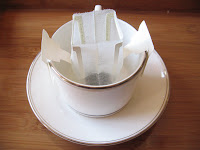
Tea: Gyokuro
Vendor:
BassaroSource: Koga Chagyo, Yame, Japan
Vendor Notes: Appelation Kurogi Controlee
While i'm not sure what product on their online shop this sample I received from them corresponds to, I will do my best to do this wonderful tea justice.
Firstly the sample came in a small mylar sealed package containing 6g of gyokuro leaf. It is a bit difficult to see in the picture above, but the leaf itself was even gorgeous, it was a beautiful shade of dark green and has a certain allure to it which I cannot begin to describe.
For the purposes of this review I brewed the gyokuro with 30ml (it really was a tiny amount of water) infusions starting at 50C (122F) working my way up in temperature. These were the suggested brewing instructions given with this tea. This is cooler than I am used to starting gyokuro with, normally starting around 150F(65C). I then increased the temperature gradually on subsequent infusions.
The first infusion of this tea (shown below) was very dark and rich in color. Due to the relatively low temperature there was not much of an aroma to the tea at this point. The flavor was rich and vegetal. It was very bold, but at the same time a relatively shortlived flavor. It was an amazing Gyokuro flavor in a concise burst with no aftertaste.

The first infusion on its own was a wonderful experience, but then I was shocked on the second infusion. This infusion was very similar to the first in appearance, dark and cloudy. It also had the same rich gyokuro flavor, and this time it had a slight astringency and a light bitterness to it. It was still rich and vegetal with a concise flood of flavor.
Just when I thought that this tea was amazing, I got to try the third infusion. This one was an emerald green color, having washed out most of the smaller particles out during the first two infusions. This time the flavor switched from being vegetal to a grassier flavor, but still full of flavor with no signs of letting up. The sense of astringency was growing though, this time up to a medium level.
Showing no signs of letting up this tea produced a fourth infusion. This one was a little lighter in flavor, but the flavor was sweeter, showcasing that sense of natural sweetness which Gyokuro is well known for. The astringency did build up even further this time though.
By the fifth infusion the tea had become a lighter flavor, but showed an amazing pairing of sweetness and the grassy/vegetal flavor exhibited earlier on in the tastings. The flavor was starting to show lightening up at this point.
The final infusion, which I almost expected to have given up by now, was still amazing. It was a much lighter green color and didn't have nearly as much power as before, it still possessed a wonderful flavor and at this point transitioned into tasting almost like a wonderful sencha.
Rating: 10/10
Conclusion: This is an amazing sample of gyokuro. It lasted for significantly longer than I expected showing all sides of the flavor of gyokuro. Each infusion showed a brilliant character which if a tea produced only that flavor alone would still be amazing. These all came from one sample of tea though. If I could get some, I would order this to be the most special of special occasion gyokruos.
 Tea: Snow Dragon
Tea: Snow Dragon 1st Infusion: The infusion had a very reminiscent green tea smell. It reminded me very much of the aroma from a dragonwell. Unlike a dragonwell though this tea had a very strong bitterness to it. The strength of the bitterness slowly built up and then quickly cut off to nothing. The flavor of the tea though was reminiscent of a dragonwell. One very unusual thing about the liquor was the very small black flecks that were floating around on the surface. I'm not quite sure what those were from.
1st Infusion: The infusion had a very reminiscent green tea smell. It reminded me very much of the aroma from a dragonwell. Unlike a dragonwell though this tea had a very strong bitterness to it. The strength of the bitterness slowly built up and then quickly cut off to nothing. The flavor of the tea though was reminiscent of a dragonwell. One very unusual thing about the liquor was the very small black flecks that were floating around on the surface. I'm not quite sure what those were from.




































